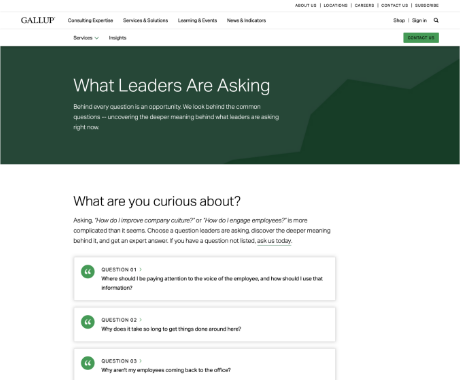Story Highlights
- Including many voices in key decisions can increase buy-in and ownership
- Listening posts often reveal unforeseen issues and opportunities
- Use five pieces of advice to improve how you listen to your employees
Many corporate leaders are talking about the importance of “voice of employee” in decision-making. But what does that really mean? And how can leaders get it right?
According to Gallup, globally only one in four employees strongly agree their opinions count at work. This means that most employees do not feel their suggestions or ideas on how to make their work better are listened to.
Involving as many employees as possible to offer input on key decisions is a proven way to generate buy-in and ownership of change and outcomes. Setting up internal “listening posts” can alert leaders to their potential blind spots in their own thinking by bringing in new perspectives, concerns and ideas.
This can make voice of employee seem like a win-win from a business standpoint -- and a human standpoint. New technology tools (like Gallup Access) allow leaders to send out quick pulse surveys to employees to receive real-time data on how employees think and feel. These tools have the potential to bring employees’ opinions to the leaders of large organizations, something that wasn’t possible before.
And yet, many well-meaning efforts to listen to employees are likely to fail if leaders skip the strategy part of their listening strategy.
In our experience working with some of the world’s largest and most successful organizations, these attempts to include voice of employee often lead to lackluster results (or even backfire) because they get distracted by the quick fix -- which ends up not being a fix at all.
Here’s what we know from our hands-on experience working with leaders:
1. Before you set up a listening post, think through the implications of having one.
Input is just the beginning. Answers can lead to more questions. Data are simply a foundation for further investigation and learning. Ask yourself and your leaders, “Are you ready for this?” An effective listening post requires a response team with the authority, capacity and will to respond to and affect change. A pulse survey app may be quick and easy, but a true listening strategy is not free in time or resources.
Involving as many employees as possible to offer input on key decisions is a proven way to generate buy-in and ownership of change and outcomes.
2. First, use the data you already have.
When clients ask us to help them with their workplace culture problems, they usually have data -- performance data, exit interviews, old survey results -- that could already be telling a story. Or it may help them ask better questions. Leaders should be cautious about seeking out more input on topics that they could easily resolve with what they already have.
3. You must take action on and communicate survey results.
Gallup worked with a client who sent a companywide survey for new product ideas. They received over 9,000 responses. Guess what they did with them. Nothing.
Was it a good decision to ask employees for ideas? Yes. It turned out that once the responses were analyzed, several good ideas emerged.
Was it a good idea to sit on the data for months without a response? No. It frustrated employees who took the time to offer feedback that no one acknowledged or took action on. Having a plan to communicate and take action before collecting input is essential if you want honest feedback.
Surveys can build trust, generate ideas and provide essential feedback on important issues. The difference between success and failure is how leadership communicates the message they’ve received and what will happen next.
4. Beware of survey fatigue. (Treat your questions like gold.)
We believe pulse surveys can be a helpful tool for leaders throughout the business year. These surveys provide real-time feedback and input in a business environment that seems to move faster every year.
It can be tempting to send out surveys for everything from coffee preferences to party plans. Just be careful not to overload employees. Instead, treat every survey question like a nugget of gold. Is the answer you’re going to receive worth gold to you? Every time you ask employees to take pulse surveys, you’re taking their time away from work, so remember that this type of survey should give your business a return on the investment of respondent time.
5. Don’t use surveys to replace conversations.
A survey cannot replace a relationship. And it should never be used as a “feel good” measure to make employees feel like they matter. A leader’s everyday listening strategy includes getting away from their desk, walking the floor, having quick conversations and building rapport that allows for trust and candor. Pulse and census survey results are a starting point for more conversations. And it’s these moments when organizational cultures truly change.
A survey cannot replace a relationship.
Ready to Listen?
Voice of employee is a powerful concept that can transform the way leaders make decisions and have a positive impact on their organization. But it is not a simple solution that can solve all problems. Leaders need to be strategic, intentional and accountable when they seek out and act on employee input. Otherwise, they risk wasting time, money and trust. By following the above principles, leaders can create a listening strategy that works for their organization and employees.
Your employees have something to say, but do they have a voice?
- Learn how to capitalize on voice of employee to benefit your organization.
- Use the surveys on Gallup Access to discover what employees think.
- Partner with Gallup to develop a listening strategy that suits your unique needs.





